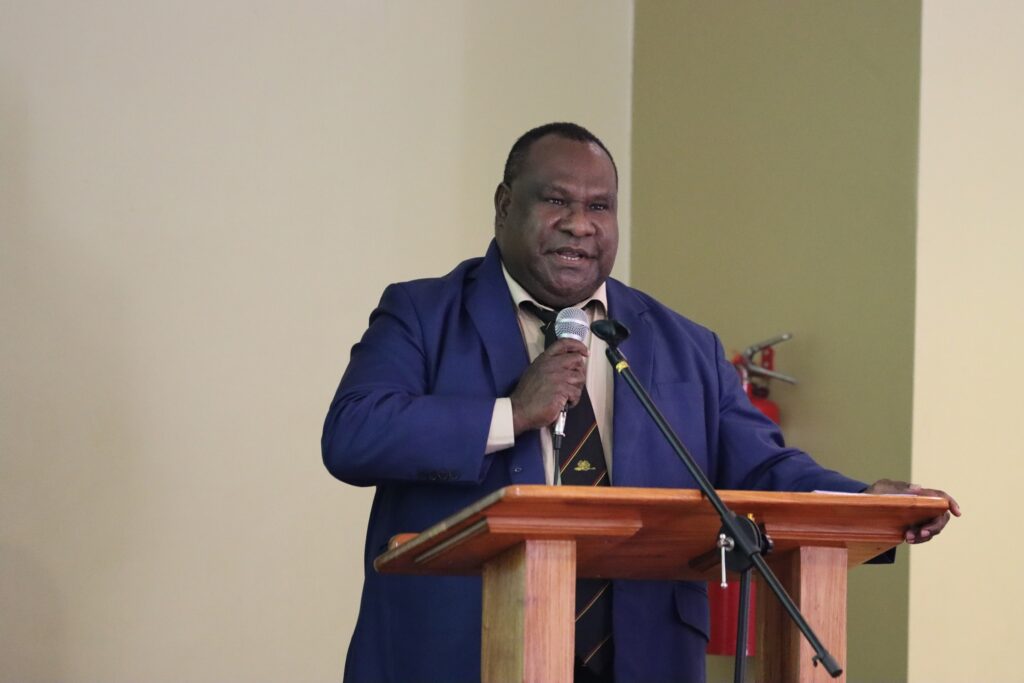Lae, Morobe Province – Thursday, 10 April 2025 – The Director General of the National Agriculture Research Institute (NARI), Dr Nelson Simbiken, has delivered a powerful and sobering address at the National Agriculture Industry Public-Private Sector Partnership Conference in Lae, challenging the nation to radically transform its agriculture sector, research systems, and institutional frameworks to ensure rural Papua New Guineans are no longer left behind.
With emotion and urgency, Dr Simbiken laid bare the reality that after 50 years of independence, nearly 90 percent of Papua New Guinea’s population remains trapped in rural poverty. He questioned what the next 50 years would look like unless deliberate and coordinated action was taken to bring meaningful development to the agricultural heartlands of the country.
“Fifty years on, 90 percent of our people remain stuck in the rural areas. They are still there, entrapped in poverty. If we are to truly transform, we must change how we think, how we work, and how we deliver,” Dr Simbiken told the conference.
A Research Legacy with Untapped Potential
Dr Simbiken traced NARI’s origins to its establishment in 1997 under an Act of Parliament, with a mandate to deliver agricultural innovations to improve food security, nutrition, rural incomes, and sustainable natural resource use. Over 27 years, NARI has released 27 significant technologies, including high-yielding and climate-resilient varieties of bananas, rice, taro, cassava, and sweet potato, as well as cost-effective poultry feed and drought preparedness information systems.
Yet despite these achievements, he expressed deep concern that these innovations have not been scaled up into industries or commercial solutions that reach rural farmers.
“Some of the taro varieties you’ll never find anywhere else in the world—except here. We have drought-tolerant rice and cassava. But these technologies have not moved beyond the research station. That is a systemic failure,” he said.

Struggling Under the Weight of Neglect
Dr Simbiken did not shy away from highlighting the chronic underfunding of NARI and its six agro-ecological research centres across PNG, including those in Bubia, Laloki, Aiyura, Tambul, and Keravat. He revealed that NARI has operated with an average annual allocation of under K10 million for many years—barely enough to sustain core operations, let alone drive innovation or expansion.
He described frequent power outages that disrupt research processes, particularly tissue culture and biotechnology labs, and rising fuel costs associated with maintaining backup generators. The research stations also face ongoing law-and-order challenges and land encroachment issues.
“The infrastructure is decaying. Power cuts are frequent. We are running on generators, and the cost is unsustainable. Our scientists are demoralised, underpaid, and many leave for universities or better-funded institutions,” he said.
A Vision for Transformation
Calling for nothing short of a paradigm shift, Dr Simbiken outlined NARI’s comprehensive transformation agenda. Central to this vision is a full institutional review of NARI’s operations, structure, and the NARI Act of 1996. He announced the formation of a Research and Advisory Committee to enhance public-private engagement in setting research priorities.
He said NARI was also aligning its work with the National Agriculture Sector Plan (NASP) 2024–2033 and Medium-Term Development Plan IV, ensuring all its strategic priorities—such as market-driven value chains, household resilience, food safety, and agroecological systems—fit within the government’s broader development goals.
“Transformation is not just about technology. It is about transforming people, institutions, and processes. We must equip farmers with tools, knowledge, and structured pathways from subsistence to small-scale enterprise. If we don’t introduce innovation to our farmers, they will improvise—and often, wrongly,” Dr Simbiken said.
Institutional Renewal and Talent Development
Dr Simbiken stressed the need to rejuvenate NARI’s scientific workforce. He lamented the decline in the quality of university graduates and the absence of structured training to prepare them for field and lab-based research. He highlighted the success of NARI’s past cadetship programme, which produced notable agricultural entrepreneurs such as Joel Waramboi, now an exporter and business owner.
“We must reinstate the National Agriculture Cadet Scheme and institutionalise a master farmer accreditation pathway. Farmers should be treated like tradesmen—trained, certified, and empowered,” he said.
He also called for salary reform within NARI, proposing that research staff be paid at the same levels as university academics to attract and retain top scientific talent.
Policy and Legislative Proposals
In a series of forward-looking policy proposals, Dr Simbiken recommended:
- Completion and implementation of the NARI Act review
- Establishment of a National Agricultural Research and Development Grant through legislative budget appropriations
- Removal of tariffs on imported farm machinery to lower costs for commercial agriculture
- Introduction of a legal framework for biotechnology and gene-based crop innovation
- Establishment of a centralised digital agriculture information system to improve access to research data and resources
Dr Simbiken also proposed the formation of a subcommittee under the National Agriculture Council to coordinate agricultural research and development efforts across all institutions in the National Agricultural System (NAS).
“We must stop operating in silos. NAS institutions, government departments, and private sector players must work together to plan, finance, and implement innovations that reach the farmer.”
A Call to Collaborate
In closing, Dr Simbiken appealed to all delegates at the conference to join hands in building a more inclusive and effective research and development system.
“The agricultural research system is stagnant. It is hibernating. We must reawaken it and reimagine how we grow. If we transform together, we will thrive together.”
His presentation set the tone for the conference’s final day of high-level policy discussions and collaborative planning, aimed at ensuring research, innovation, and institutional reform are embedded in the future of Papua New Guinea’s agriculture sector.
###